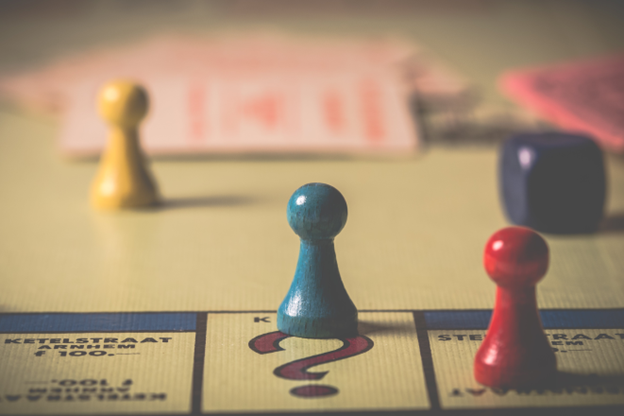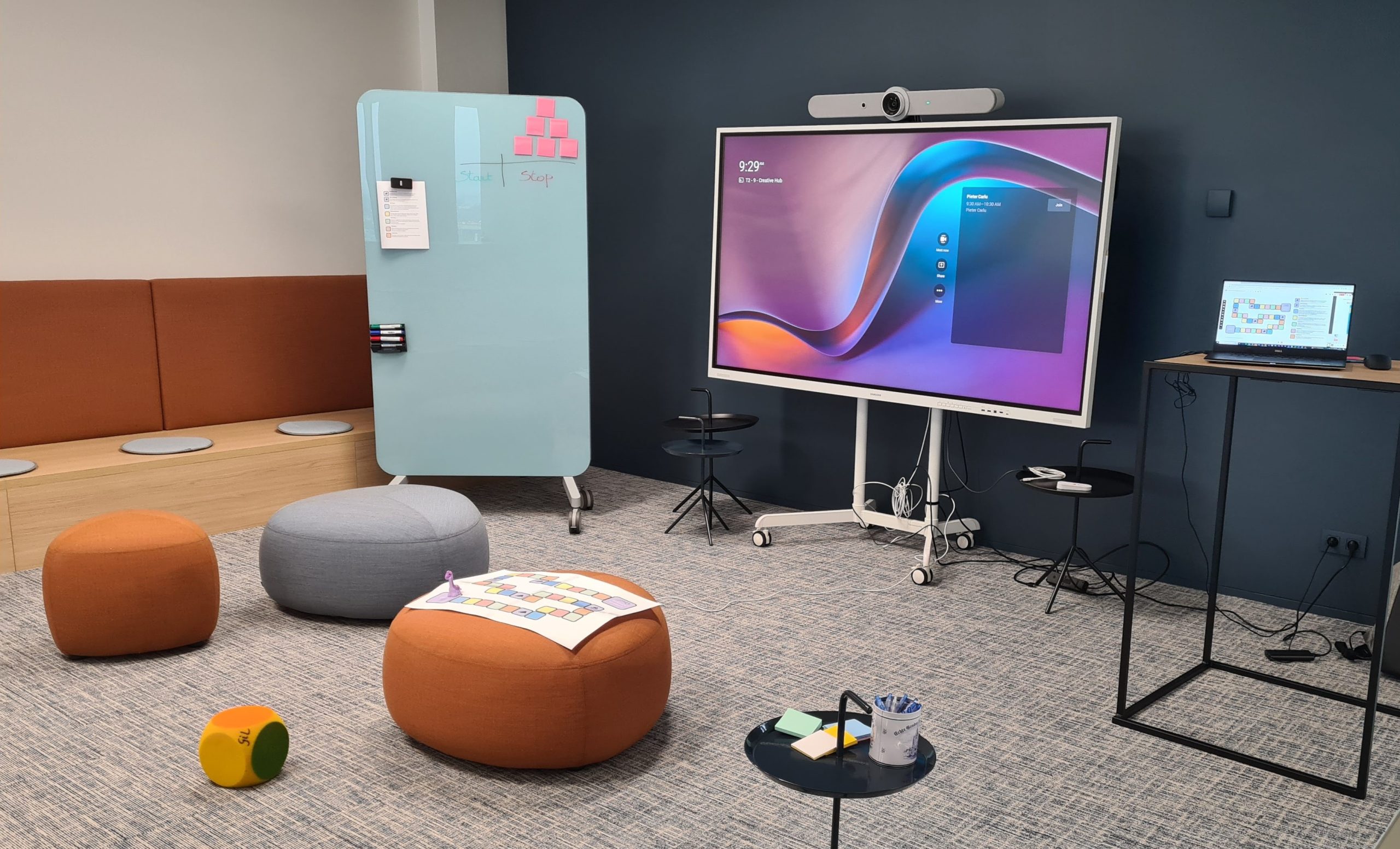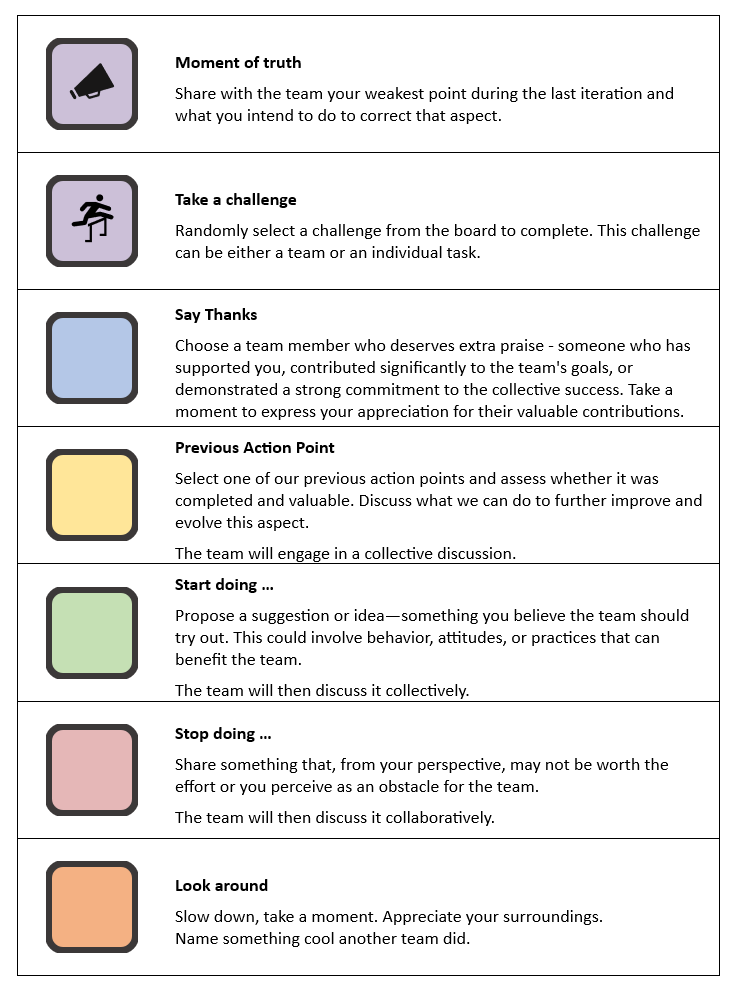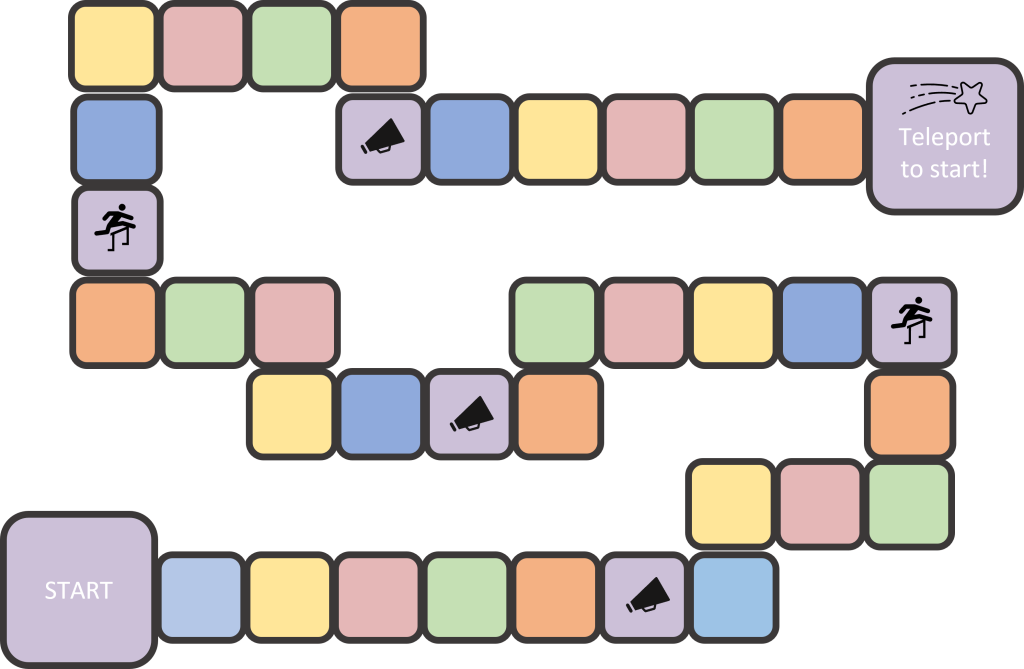Retro recipe
A colorful roll

Welcome, fellow players, to our colorful roll retrospective! Picture the past sprint as a board game waiting to unfold, each move dictated by a roll of the colored dice. One goal in mind: achieving victory together by gaining valuable insights and actionable takeaways.
Are you ready to roll? Let the gaming begin!
Ingredients
- A board, a list of color categories, and a list of challenges, all printable using the provided Mural template
- A pawn to represent your position on the board
- A colored six-sided dice
- A whiteboard or wall, along with sticky notes and pens to visualize defined action points during the retro
- Meeting room space, allowing the team to comfortably gather around the board and roll the dice
- Your awesome team
Setup
In the meeting room, position the board game strategically so that the team can easily surround it. Place your pawn on the board and designate an area for rolling the dice. This setup ensures a central focus on the board while allowing ample space for interactive participation and engagement.

Hang the list of color categories in a visible spot for the entire team or display it on a big screen. Allocate a dedicated section for adding sticky notes with defined action points during the retro. Our team utilizes a whiteboard for this purpose.
Additionally, on the same board, include sticky notes containing potential challenges, which can be drawn during the game, enhancing the element of surprise and randomness.
This format is most effective with a smaller team, ideally up to 10 members. If the team is larger, consider dividing into two groups to maintain engagement and facilitate an environment for intense collaboration. In such a scenario, double the materials to set up the format twice.
Retrospective (1h30)
Setting the scene (5 min)
Before starting, it can be helpful to remind the team of some guidelines for a retrospective. The specifics may vary depending on the Agile maturity of the team; however, they should aim to create a secure and open space where everyone's opinions and perspectives are valued and can be shared without fear of negative consequences. Encourage team members to actively participate and be honest and transparent, as this is instrumental in maximizing the value derived from the retrospective.
Warm-up (15 min)
What board game was your favorite as a kid, or alternatively, what's your current go-to board game and why?
This question serves as an excellent icebreaker, as it not only establishes a light-hearted and nostalgic atmosphere to put team members more at ease, but also provides an opportunity for team members to share personal stories and experiences. Learning about someone's favorite board game can offer insights into their personality and interests. The overall effect is a positive and relaxed atmosphere.
The team members are given a few minutes to reflect on the question about their favorite board game. Afterward, we adopt a popcorn-style approach, where no specific order is predetermined, and neither a facilitator nor a team member designates the next speaker. Participants are encouraged to answer the question whenever they feel inspired, with the only requirement being that everyone contributes by sharing their answer. This team-building exercise aims to empower individuals to assess the room and independently speak up.
The game: a colorful twist (50 min)
Before eagerly diving into the game and rolling the dice, team members receive an explanation of the colors and their respective meanings. Much like the dice, there are a total of six colors. Participants are also given some time to brainstorm topics for each category, ensuring quick responses during their turn in the game.
Let’s play! Each team member, in turn, rolls the dice. The resulting color determines the direction of the action or discussion. The pawn is moved to the nearest square on the board that matches that color, keeping us informed of our progress.
As probably observed during the setup, there's only one pawn on the board, emphasizing the cooperative nature of the game. This is a team effort. The individual who rolls sometimes needs to perform an action or lead by suggesting a topic for the team to discuss. However, it's the team's collective responsibility to drive the discussion forward and bring value.
Let’s go over the color categories!

- When purple is rolled, the options ‘Moment of truth’ or 'Take a challenge' come into play, depending where the pawn lands on the board.
- ‘Moment of truth’ requires the player to share a personal challenge or weakness they faced during the last iteration. This exercise encourages open communication and fosters a mindset for continuous improvement, as they also need to outline a plan for addressing and improving that aspect moving forward.
- The ‘Take a challenge’ aspect adds an element of fun and creativity to the retrospective process. When a team member rolls and lands on this category, they select a blind sticky note on the board, unveiling a short team or individual task. Challenges can include drawing a self-portrait as a team, playing rounds of Pictionary, collaboratively creating a story sentence by sentence, winning rock-paper-scissors, telling a joke, or sharing recent impressive movies.
- The blue category tasks the active player with expressing gratitude. They must 'say thanks’ to a team member who deserves extra praise, offering a genuine compliment to recognize their contributions. This activity not only recognizes individual efforts but also fosters a positive and appreciative team culture by boosting morale.
- In the yellow category, we rewind a bit and revisit a 'previous action point' defined in a past retrospective. Either the active player brings up one, or the facilitator has prepared a list. The goal is to reflect together and assess the completion and value of that particular initiative. Doing so helps us learn from past experiences, celebrating successes or adjusting and improving if necessary.
- The green category opens the floor for the active player to throw out a new idea or suggestion they think could benefit the team. This kicks off a creative and collaborative discussion where everyone dives into fresh ways of doing things—whether it's trying out different behaviors, adopting new attitudes, or testing out practices that could boost productivity or create a more positive working environment. New action points from the discussion on what we should 'start doing' are added to the whiteboard.
- The red category provides a platform for team members to candidly express perceived obstacles or challenges for the team. The active player brings up a topic to start the conversation. After sharing their concerns, the team initiates a collaborative discussion to address these challenges, trying to formulate concrete action points for improvement, which are added to the whiteboard. This collective dialogue in the red category 'stop doing' promotes a proactive approach to problem-solving, fostering a culture where obstacles are acknowledged, triggering a mindset for continuous improvement.
- The last category, orange, was added to assess our team's awareness of the activities of other teams and to encourage them to 'look around'. Understanding and being informed about the work of other teams is crucial for fostering collaboration, sharing knowledge, and ensuring alignment across the organization.
Now, what’s the role of the board? Its primary function is providing a visual representation for the team to track their progress throughout the retrospective. Additionally, the board determines the type of action to be taken when landing on the purple section, either engaging in a moment of truth-sharing or taking on a challenge, loosely inspired by the 'Truth or Dare' concept.

The board can also serve as an added incentive, with the team receiving a reward each time they pass 'Start.' For instance, during one of my team retrospectives held in the morning, we enjoyed a cup of coffee as a reward when a full rotation of the board was completed. Different rewards can be tailored to the team's preferences.
It's important to note that the focus is not on racing through the board; instead, it’s about taking the necessary time for meaningful discussions and extracting value from the process.
Summarizing action points (10 min)
During or after discussing the different interpretations of the different topics, the team formulates actions that they need to start, stop, or continue doing. These actions can be grouped using the three colored suitcases and should aim to improve their processes and tools, bringing the team closer to their ideal sprint.
If there are numerous action points, try to prioritize them based on the team's decision, ensuring a focus on the most important ones.
Rate the retro (5 min)
Lastly, the team rates how the retrospective went. To do this efficiently, everyone, on the count of three, raises their hand, showing a number of fingers, from 1 to 5, with 5 being the “Best retro every” and 1 being “Never this format again”. This is the opportunity to discuss what everyone liked and disliked about the format. What went well, and what can be improved with the next retrospective in mind?
Follow-up
The topics and action points discussed and formulated during the retrospective hold great value, yet their potential is wasted if they remain untouched.
Often, the team will already have a main location for placing retrospective notes. Pay close attention to the action points and consider highlighting them or placing them in a separate section. To ensure their effectiveness, follow up on the action points, take necessary actions, and track progress. Revisit them in the next retrospective to assess their implementation and discuss any outcomes or learnings. Through these steps, you can maximize the impact of the retrospective and drive positive change within the team.
Personal experiences with the format
At Skyline, where we operate with hybrid teams, both on-site and remotely, we organized our retrospectives accordingly. Team members located at the headquarters join meetings equipped for conferencing with those working remotely or from home. Remote members utilized the Mural to move a virtual pawn across a duplicate of the game board, synchronized with the one in the meeting room. During their turn, they roll a virtual colored dice instead of the physical one. A link to such a dice can be found on the Mural board listed in the ‘Ingredients’. This adaptation ensures a seamless integration.
The retrospective format has been a well-received success at Skyline so far, having been utilized multiple times. One of my teams gave it an average rating of 4.5 out of 5 stars, and other teams rated it a 79% and 72.6%.
This retro stays fun because of the exciting element of chance – a dice! While the game itself may not be the most challenging of board games or have intricate gameplay, that’s not its focus. Its primary purpose is to inject a touch of humor and interactivity into the retrospective, keeping team members actively engaged, fostering a fun and interactive environment during retrospectives. I hope you give this recipe a try yourself!
